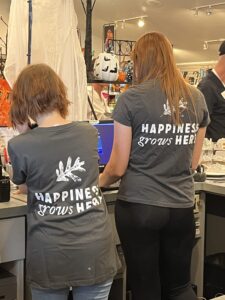The Rules of Engagement
A tumultuous economic climate, droughts and other forces of nature can make it difficult to make a profit. Add to this identifying, hiring and leading a multigenerational workforce, and there’s a lot to think about. But there are specific steps owners and managers can take to build and maintain a workplace culture that is meaningful to everyone. Success in this area has a direct impact on your customers who enjoy buying from employees who are happy, friendly and knowledgeable.
Employee Engagement Defined
A lack of loyalty carries a price tag. Engaged employees who are empowered by their superiors can make the difference between happy customers and those who will walk out your door and never look back! Engagement is the latest intervention strategy aimed at intellectually and emotionally binding employees to you and your business.
The result: Engagement, in tandem with empowerment, can significantly impact sales, customer satisfaction, innovation, employee loyalty, turnover, efficiency, quality, safety, productivity and profitability.
Three Levels of Engagement
According to a 2006 Gallup study, there are three levels of employees engagement:
Passionately engaged. These are the employees who love what they do and thrive on challenges and opportunities. They go above and beyond for their customers, and they make you proud!
Steve McShane, owner of McShane’s Nursery and Landscape Supply in Salinas, Calif., sets the example for his employees. He’s owned his business for three years and hung a sign over his office door: “The Positive Attitude Advantage.” McShane believes that before one can passionately engage and motivate employees, the leader has to have a great attitude, even when times are tough.
In addition, he gives his employees what he calls “rock-star status” by recognizing them in front of customers and coworkers. He created the Gardening Academy, which is taught exclusively by employees on a variety of popular subjects. It’s a great marketing strategy and another way to engage employees who are eager to do their part as instructors to keep the traffic flowing.
Non-engaged. Most of these people have emotionally “checked out.” They appear to be working for nothing more than a paycheck. Try not to hire them, but if you already have them on your payroll, don’t give up on them. Some are worth “rescuing.”
Actively disengaged. These employees are not just unhappy at work; they act out their unhappiness. They often undermine what their engaged coworkers have accomplished. Approximately 17 percent of the average workforce fall into this category.
The Cost of Disengaged Employees
The Gallup study found that disengaged employees cost the U.S. economy approximately $300 billion every year in lost productivity. If you want to increase the engagement level of your employees and change their mindsets from entitlement to engagement you need to understand the “drivers.”
The Drivers
There are many “drivers” that keep your employees engaged. Ongoing and honest communication are at the top of the list. Others include :
Be consistent, define expectations, and set goals. Mike Berns, a second-generation co-owner of Berns Garden Center, a 50-year-old family business in Middletown, Ohio, is an enthusiastic leader. His best advice: “Be consistent.” Make sure your employees understand the expectations, and empower them to carry out their job responsibilities. He helps employees set goals and recognizes that focused employees will stay engaged and be there for customers.
Be fair and flexible. Steve Parker and his brother Rich own Parker Gardens of Scotch Plains, N.J., a 61-year-old family business. Steve, who oversees the garden division, says the company’s turnover rate is low. They engage and empower their employees with a “fair and flexible” policy that they live by. If employees need extra time off, Steve works with them. Management tries to be fair and impartial with everyone.
Help employees develop new skills. Julie and Gary Bridenbaugh have owned Out of Eden Garden Center in Maryville, Tenn., since 1999. Julie is excited about a new hands-on interactive training program that she is rolling out with small groups of her employees. Ian Baldwin’s “Think Like Customers” program is a sales motivation and retail-training program designed to increase sales in home, garden, leisure and outdoor living industries by selling customer success. Julie sees it as an opportunity to empower her employees to take the next step in delivering the ultimate customer experience.
McShane shares this approach to education and training: From day one, he’s looking for his replacement. He wants every employee to seek greater responsibilities and opportunities continuously and reap the rewards that come from them. “The cream rises to the top,” McShane says. “In a fast-paced, intensive environment like a nursery, there are opportunities for excellence every day!”
Leave them smiling. Barry Christian, one of four retail managers for Berns Garden Center, follows the Golden Rule: Do unto others as you would have them do unto you. One of the company’s goals is for everyone to leave the store smiling. Christian describes the work environment as “a giant, happy family.” Employee also have “pet” customers who seek them out because of they special relationship they’ve cultivated. That simple gesture builds pride in their employees who feel a sense of ownership as members of his team, and it definitely keeps everyone smiling!
Get creative. Julie Bridenbaugh left last year’s ANLA Management Clinic with lots of great ideas, but one really stuck with her, which she has implemented to the surprise and delight of her employees. She bought a stamp to use on the back of each paycheck that says, “Brought to you by our customers.” The employees get the message, and Julie continues to look for creative ways to set a great example.
You and these leaders have a lot in common. They work (and play!) hard with a team of employees whose key to success is a level of comfort with their jobs, co-workers and supervisors. Empowerment and engagement are powerful tools that every business owner and manager has access to. You are the gatekeeper; how you put these management tools to use is up to you.


















 Videos
Videos





